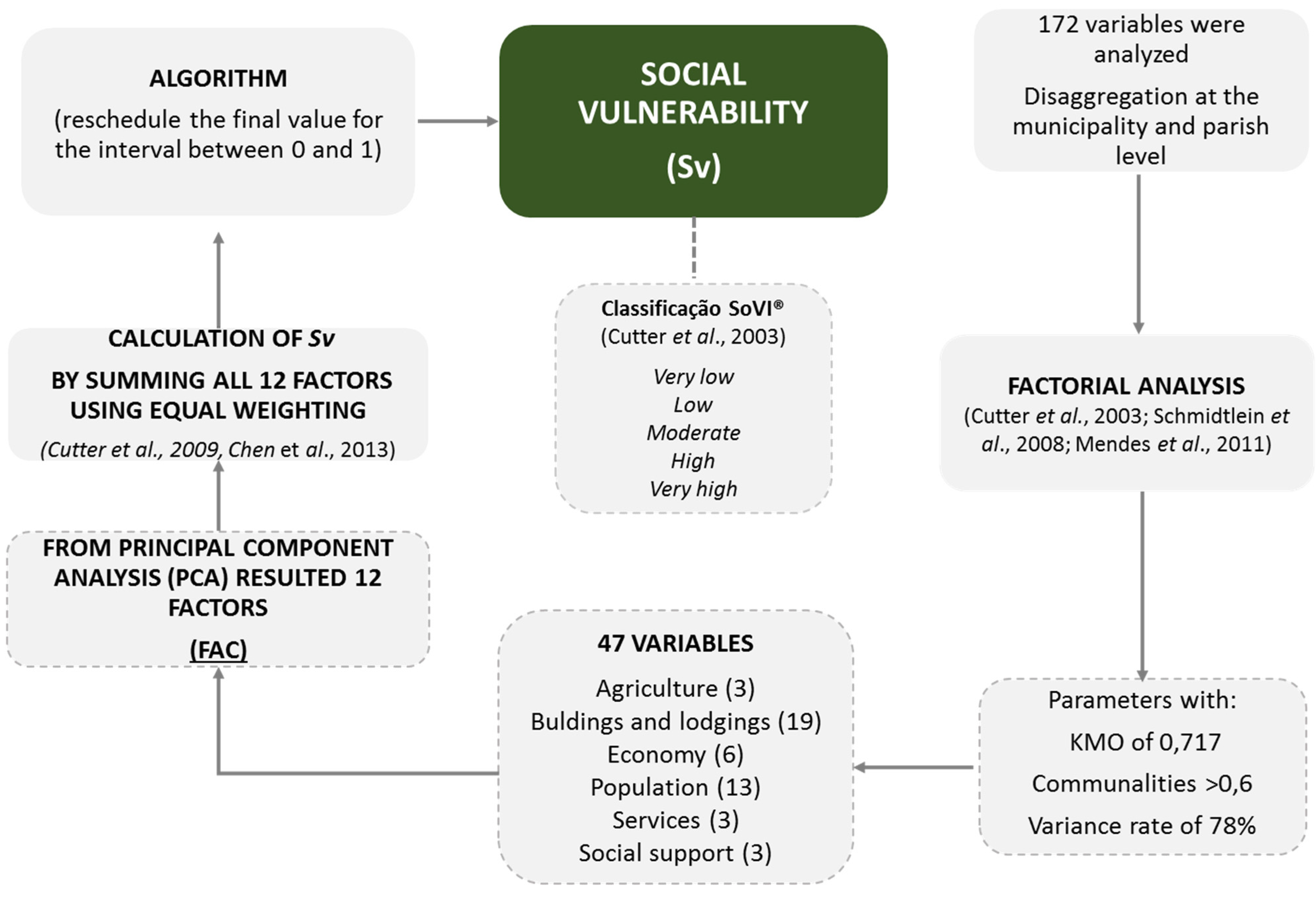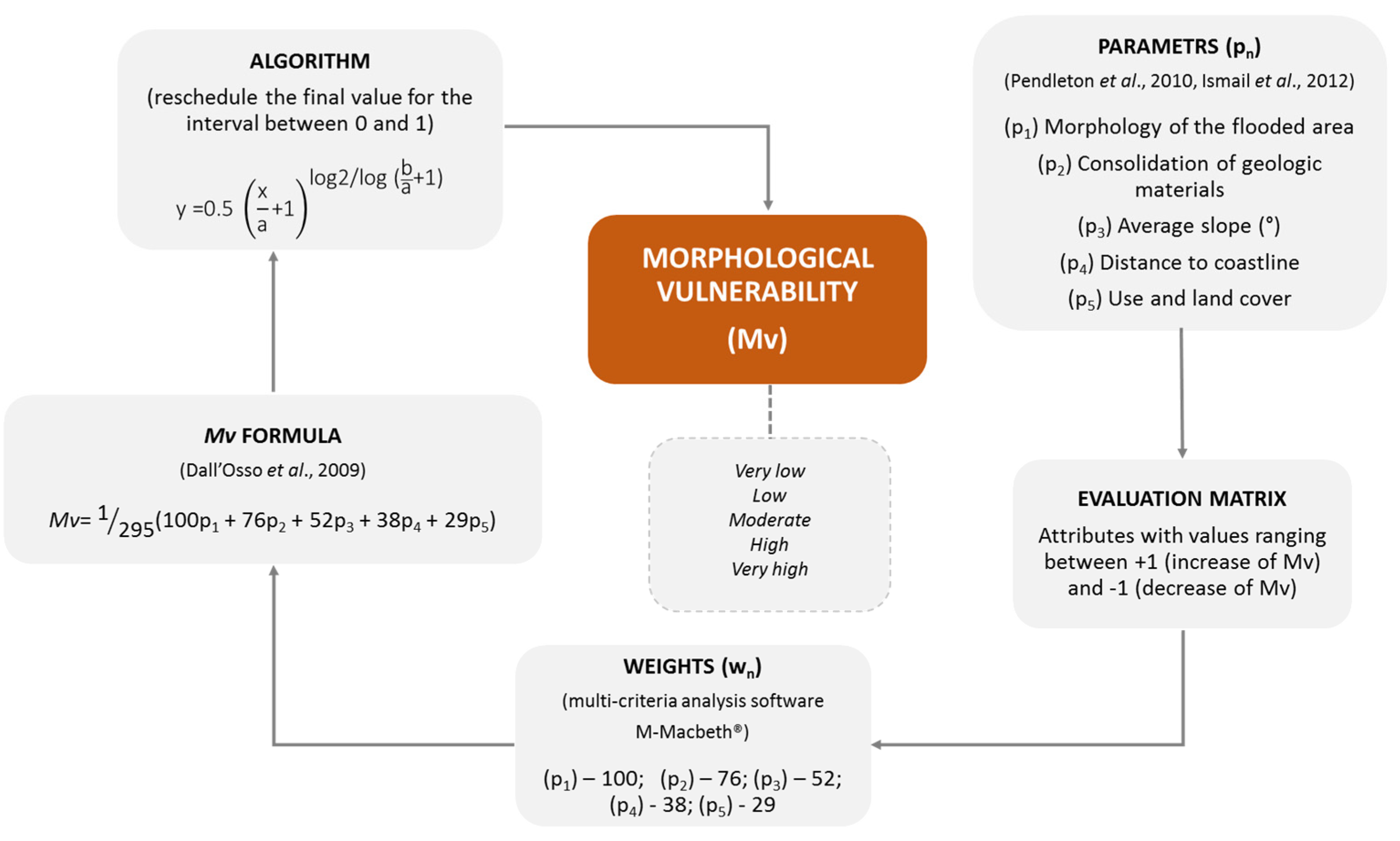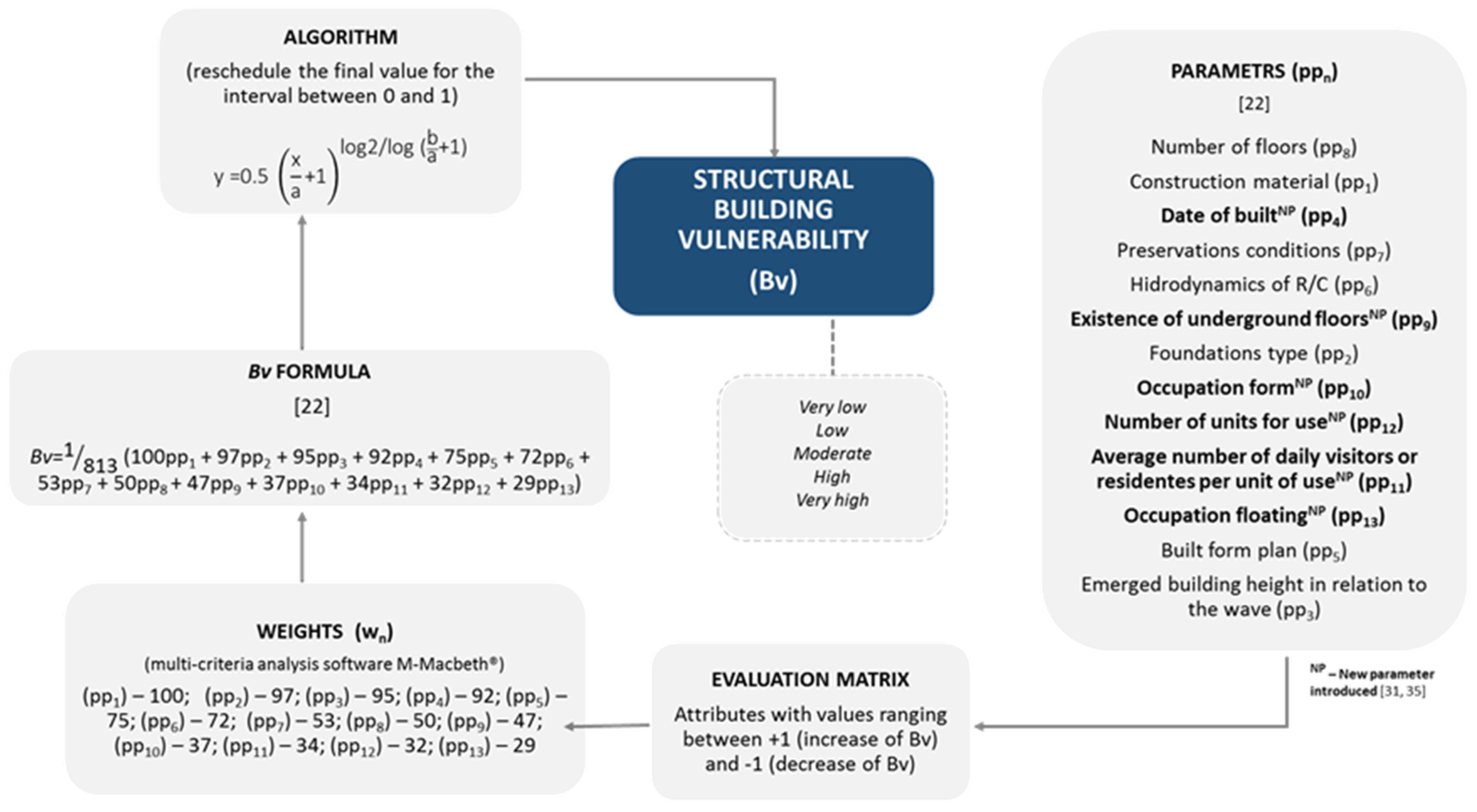Territorial Vulnerability Assessment Supporting Risk Managing Coastal Areas Due to Tsunami Impact
Abstract
:1. Introduction
1.1. Contextualization
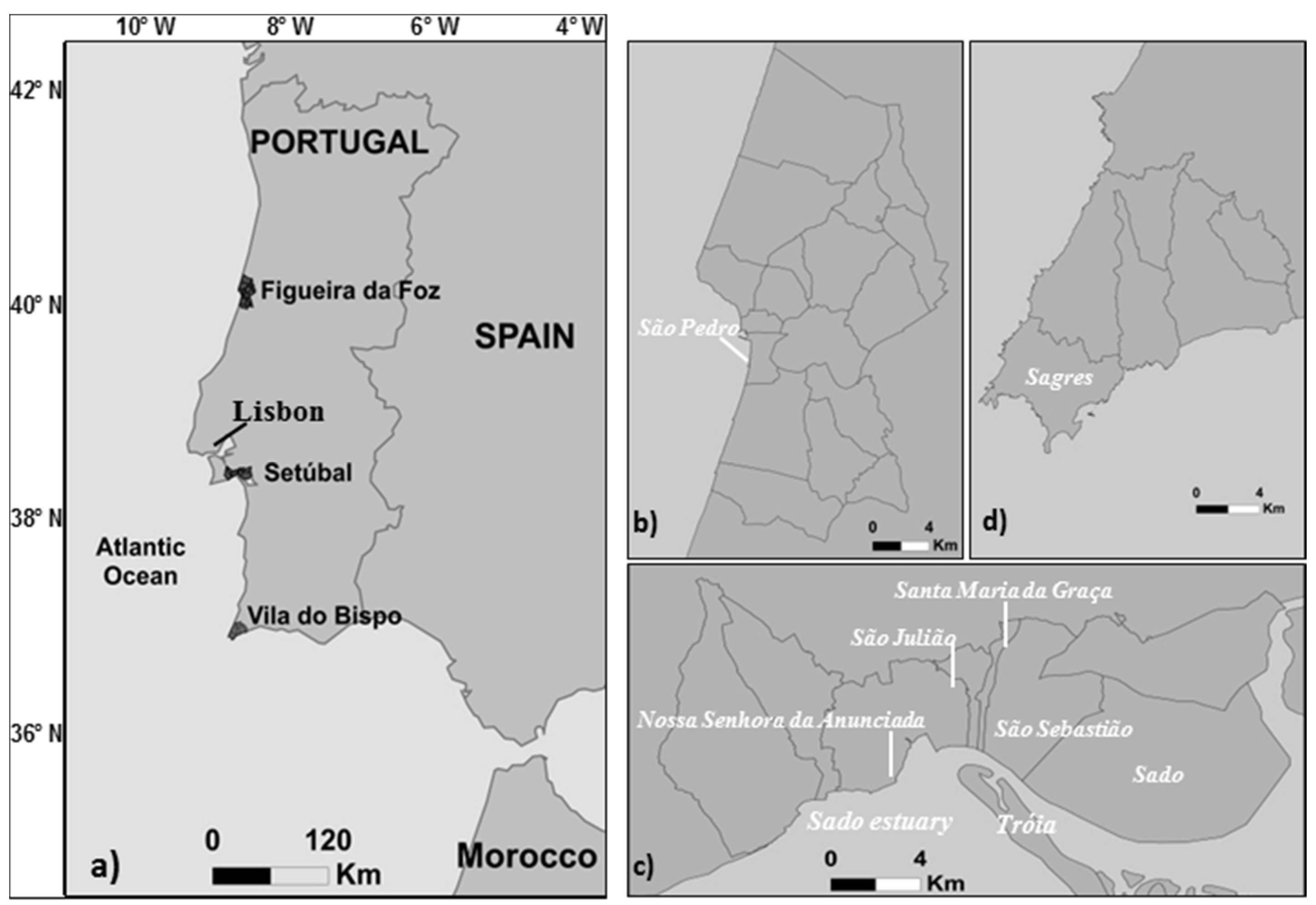
| Municipalities | Run-up (m) | Travel Time (min) | Fatalities |
|---|---|---|---|
| Figueira da Foz | 36 | 38–45 | 0 |
| Setúbal | 6–17.5 | – | >2000 (1) |
| Vila do Bispo | 10–144 | 16–17 | 0 |
- Analysis and assessment of the characteristics of beach-use areas, residential areas and industrial areas.
- Assessment of the characteristics of the buildings potentially affected by tsunami.
- Calculation and cartographic representation of the vulnerability indices for the four analysis factors (morphological, structural, social and tax characteristics).
- Calculation and cartographic representation of a Composite Vulnerability Index (CVI) using different classification levels.
- A comparison of the tsunami vulnerability classification for the different studied areas and their relation to territorial features.
1.2. Study Areas
1.2.1. Beach-Use Areas
Cabedelo (Figueira da Foz Municipality)
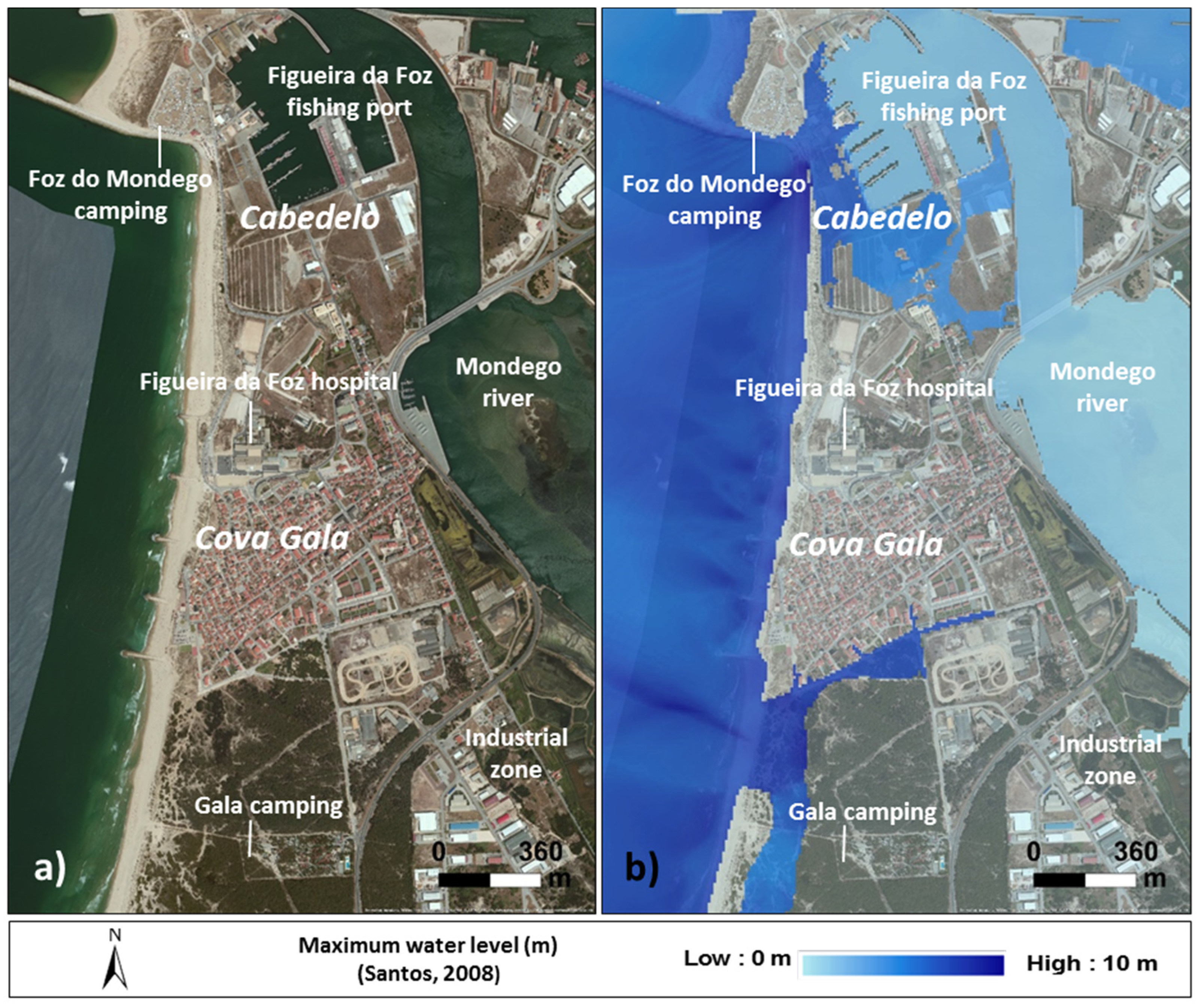
Martinhal (Vila do Bispo Municipality)
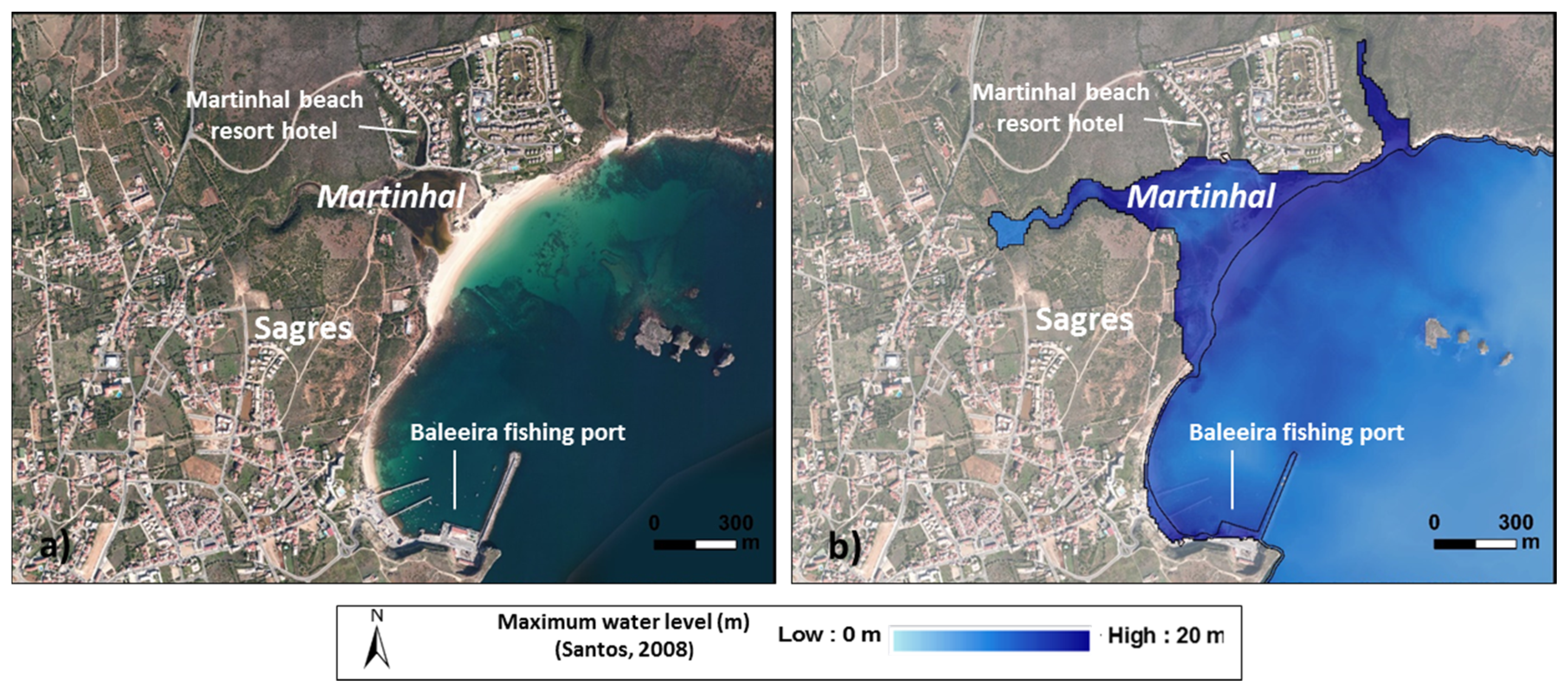
1.2.2. Residential Neighborhoods
Cova Gala (Figueira da Foz Municipality)
City of Setúbal (Setúbal Municipality)
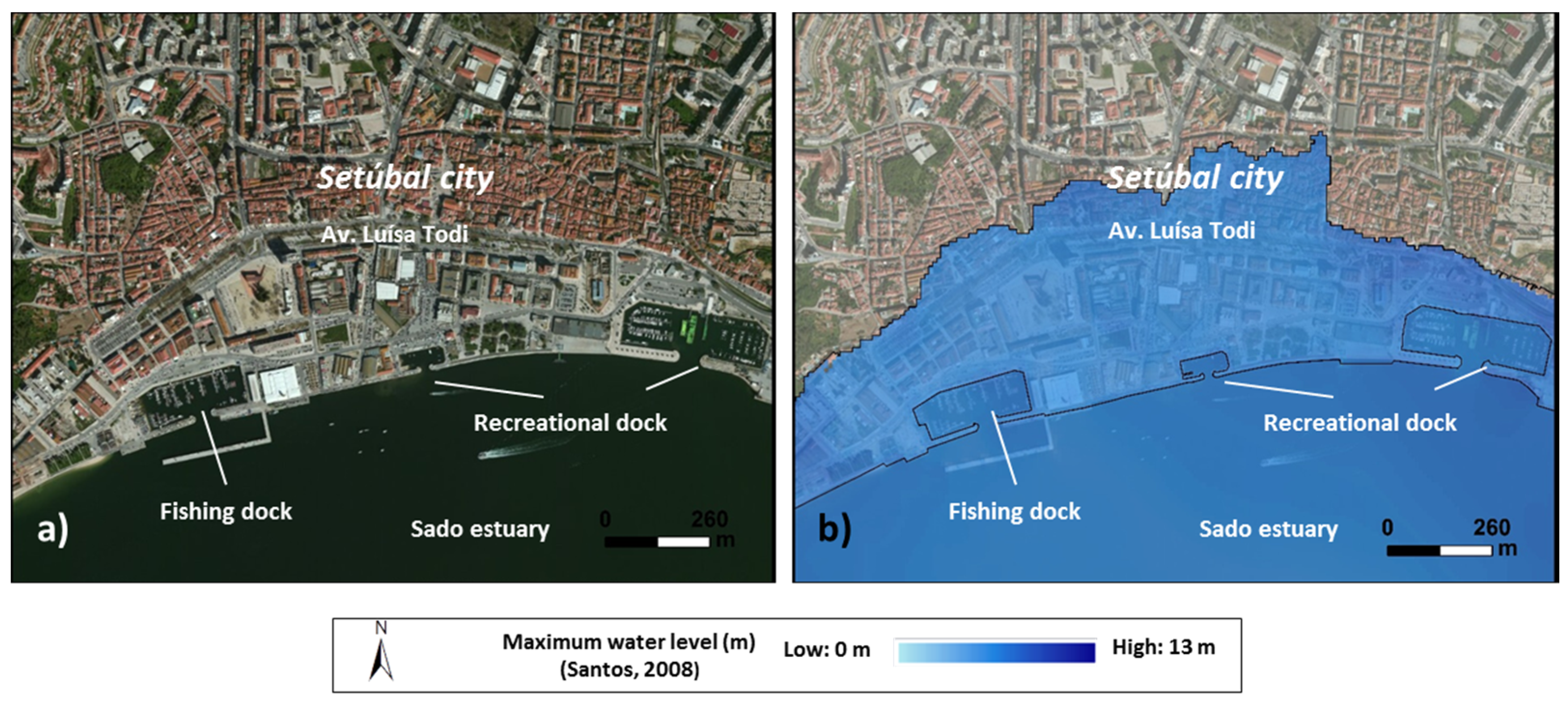
1.2.3. Industrial Areas
Outão (Setúbal Municipality)
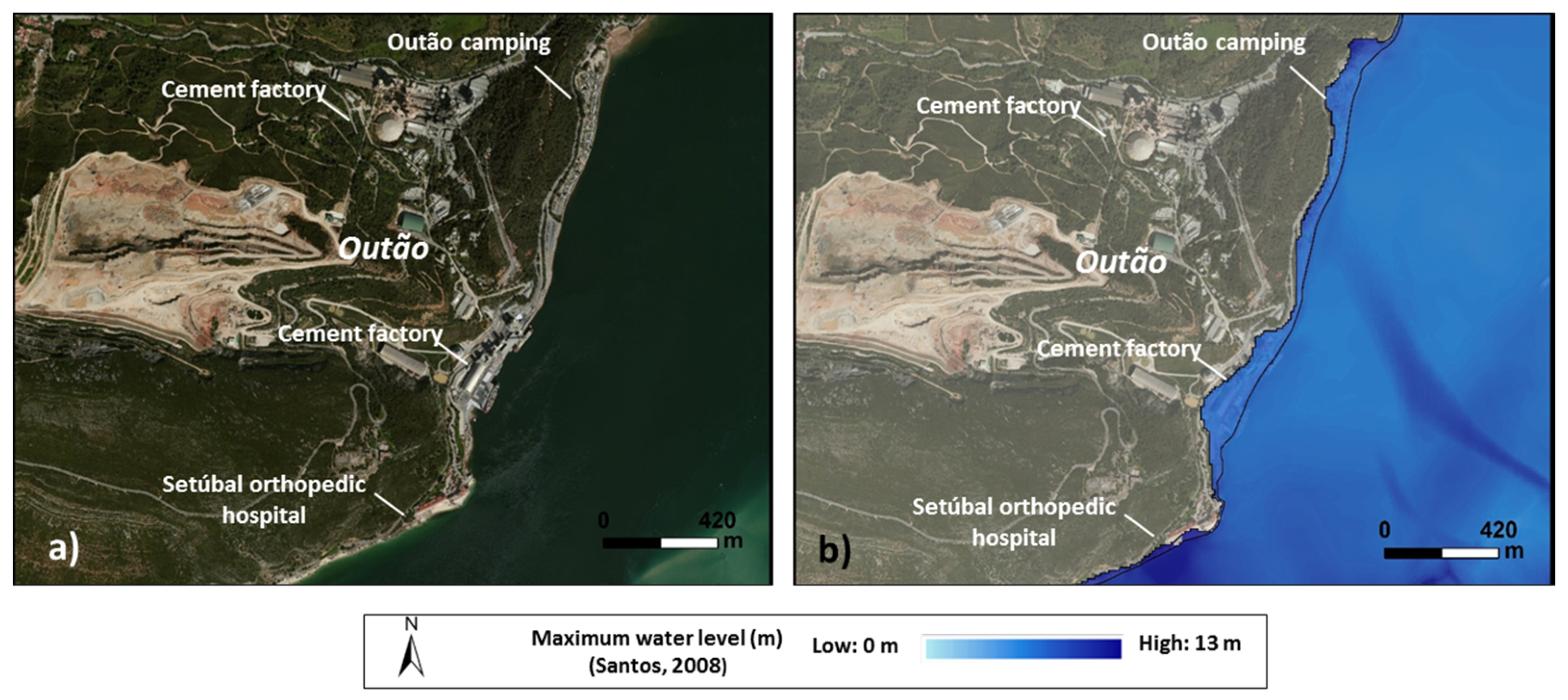
Industrial Zone of Setúbal (Setúbal Municipality)

2. Data and Methods
2.1. Social Assessment (Sv)
| FAC | Name of Component | Explanatory Variables | Explained Variance (%) |
|---|---|---|---|
| 1 | Seasonal occupation | -Proportion of the foreign population (+) | 18.9% |
| -Proportion of the employed population (−) | |||
| -Proportion of lodgings (−) | |||
| -Proportion of seasonal lodgings (+) | |||
| -Proportion of individuals per lodging (−) | |||
| 2 | Residential urban centers | -Proportion of the population employed in the primary sector (−) | 15.5% |
| -Average number of floors per building (+) | |||
| -Firefighters per 1000 inhabitants (−) | |||
| -Proportion of single parents (+) | |||
| -Ratio of the female population (+) | |||
| -Proportion of owner housing (+) | |||
| 3 | Population dynamics | -Average monthly housing rents (+) | 12.8% |
| -Rate of population change (+) | |||
| -Birth rates (+) | |||
| -Proportion of the population that 5 years prior inhabited areas outside the municipality (+) | |||
| 4 | Disadvantaged social contexts | -Proportion of individuals per household (+) | 5.8% |
| -Proportion of overcrowded households (+) | |||
| -Proportion of the population between 15 and 24 years of age (+) | |||
| -Unemployment rate (+) | |||
| 5 | Urban areas with commerce | -Proportion of predominantly residential buildings (+) | 4.4% |
| -Proportion of buildings that are not exclusively residential (+) | |||
| -Proportion of the population working in another parish (−) | |||
| 6 | Population dependent of social support | -Social support housing (+) | 4.3% |
| -Adult population in support institutions (+) | |||
| -Childcare institutions (+) | |||
| -Longevity index (+) |
2.2. Taxable Property Assessment (TPv)
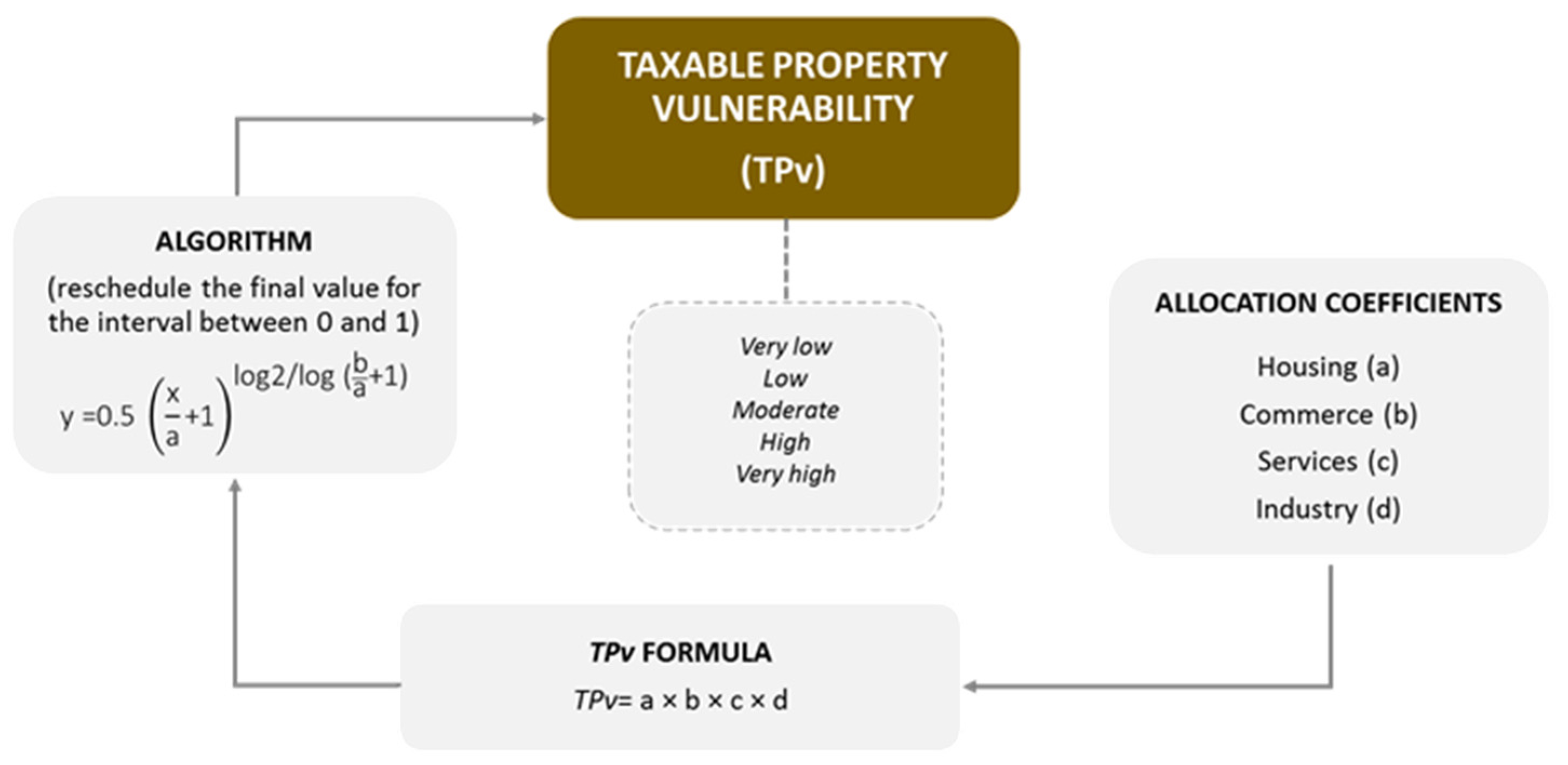
2.3. Morphological Assessment (Mv)
2.4. Structural Building Assessment (Bv)
2.5. Composite Vulnerability Index (CVI)

3. Results
3.1. Municipal Vulnerability Components
3.1.1. Social Vulnerability
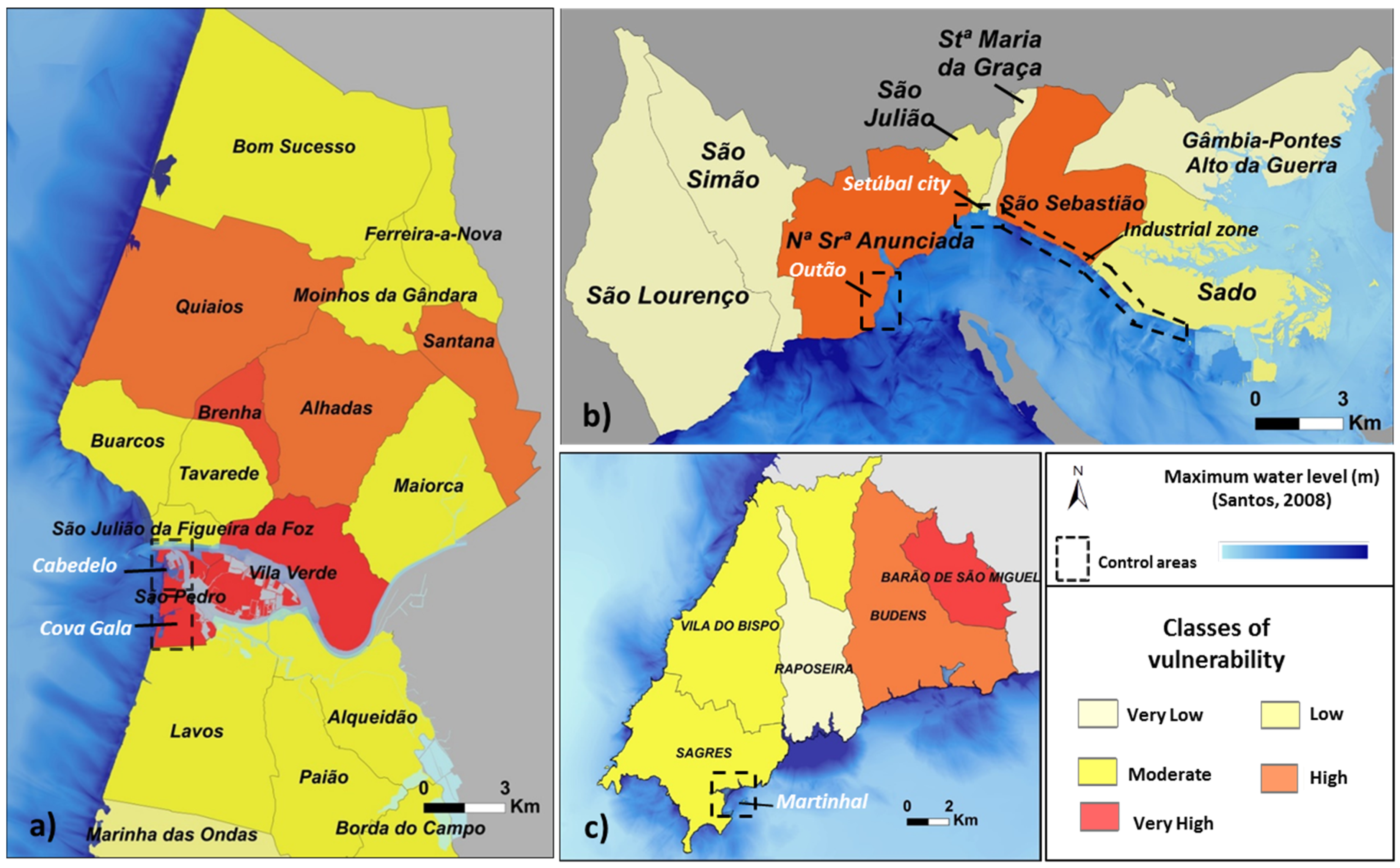
| Standard Deviation Classes | PCA Classification Interval | Nominal Classification | Municipalities | Municipal Classification Interval | Municipal Nominal Classification |
|---|---|---|---|---|---|
| <−1 SD ≥−1 to −0.5 SD ≥−0.5 to +0.5 SD ≥+0.5 to +1 SD ≥+1 SD | 0.000–0.310 0.310–0.400 0.400–0.580 0.580–0.670 0.670–1 | Very Low Low Moderate High Very High | Figueira da Foz | 0.310–0.390 0.420–0.540 0.590–0.640 0.700–0.730 | Low Moderate High Very High |
| Setúbal | 0.000–0.300 0.390–0.400 0.650–0.670 | Very Low Low High | |||
| Vila do Bispo | 0.000–0.300 0.470–0.530 0.580–0.650 0.670–0.770 | Very Low Moderate High Very High |
3.1.2. Taxable Property Vulnerability
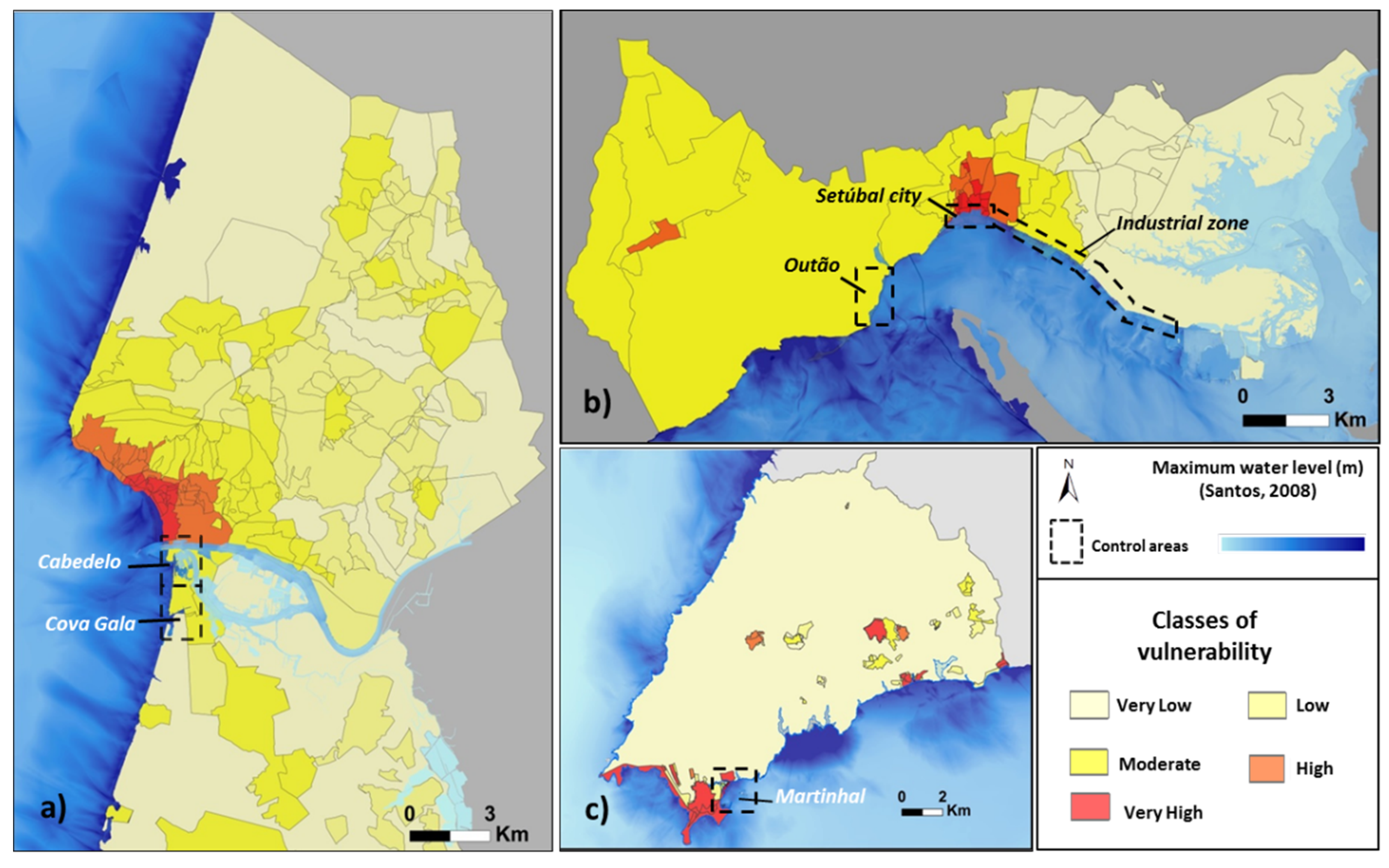
| Standard Deviation Classes | Municipalities | Municipal Classification Interval | Municipal Nominal Classification |
|---|---|---|---|
| <−1 SD ≥−1 to −0.5 SD ≥−0.5 to +0.5 SD ≥+ 0.5 to +1 SD ≥+1 SD | Figueira da Foz | 0.000–0.567 0.567–0.651 0.651–0.795 0.795–0.867 0.867–1 | Very Low Low Moderate High Very High |
| Setúbal | 0.000–0.612 0.612–0.687 0.687–0.829 0.829–0.893 0.893–1 | Very Low Low Moderate High Very High | |
| Vila do Bispo | 0.000–0.586 0.586–0.630 0.630–0.717 0.717–0.761 0.761–1 | Very Low Low Moderate High Very High |
3.2. Local Vulnerability Components
3.2.1. Morphological Vulnerability

| Study Areas | Inundated Area (% of Analyzed Area in the Municipality Total Inundated Area) | Classes of Vulnerability | Percentage of Area (%) | Area Affected (ha) |
|---|---|---|---|---|
| Cabedelo | 4.5 | Moderate | 20 | 14 |
| High | 53 | 38 | ||
| Very High | 27 | 18 | ||
| Cova Gala | 1.6 | Moderate | 20 | 5 |
| High | 48 | 12 | ||
| Very High | 32 | 8 | ||
| City of Setubal | 2.7 | Very Low | 0.7 | 0.5 |
| Low | 1 | 0.7 | ||
| Moderate | 78 | 55 | ||
| High | 20 | 14 | ||
| Very High | 0.3 | 0.4 | ||
| Outão | 0.5 | Very Low | 8 | 1 |
| Low | 14 | 2 | ||
| Moderate | 50 | 7 | ||
| High | 21 | 3 | ||
| Very High | 7 | 0.6 | ||
| Industrial zone | 4.8 | Very Low | 1 | 2 |
| Low | 3 | 3 | ||
| Moderate | 62 | 78 | ||
| High | 30 | 37 | ||
| Very High | 4 | 5 | ||
| Martinhal | 12.3 | Very Low | 3 | 1 |
| Low | 7 | 2 | ||
| Moderate | 33 | 10 | ||
| High | 17 | 5 | ||
| Very High | 40 | 12 |
3.2.2. Structural Vulnerability
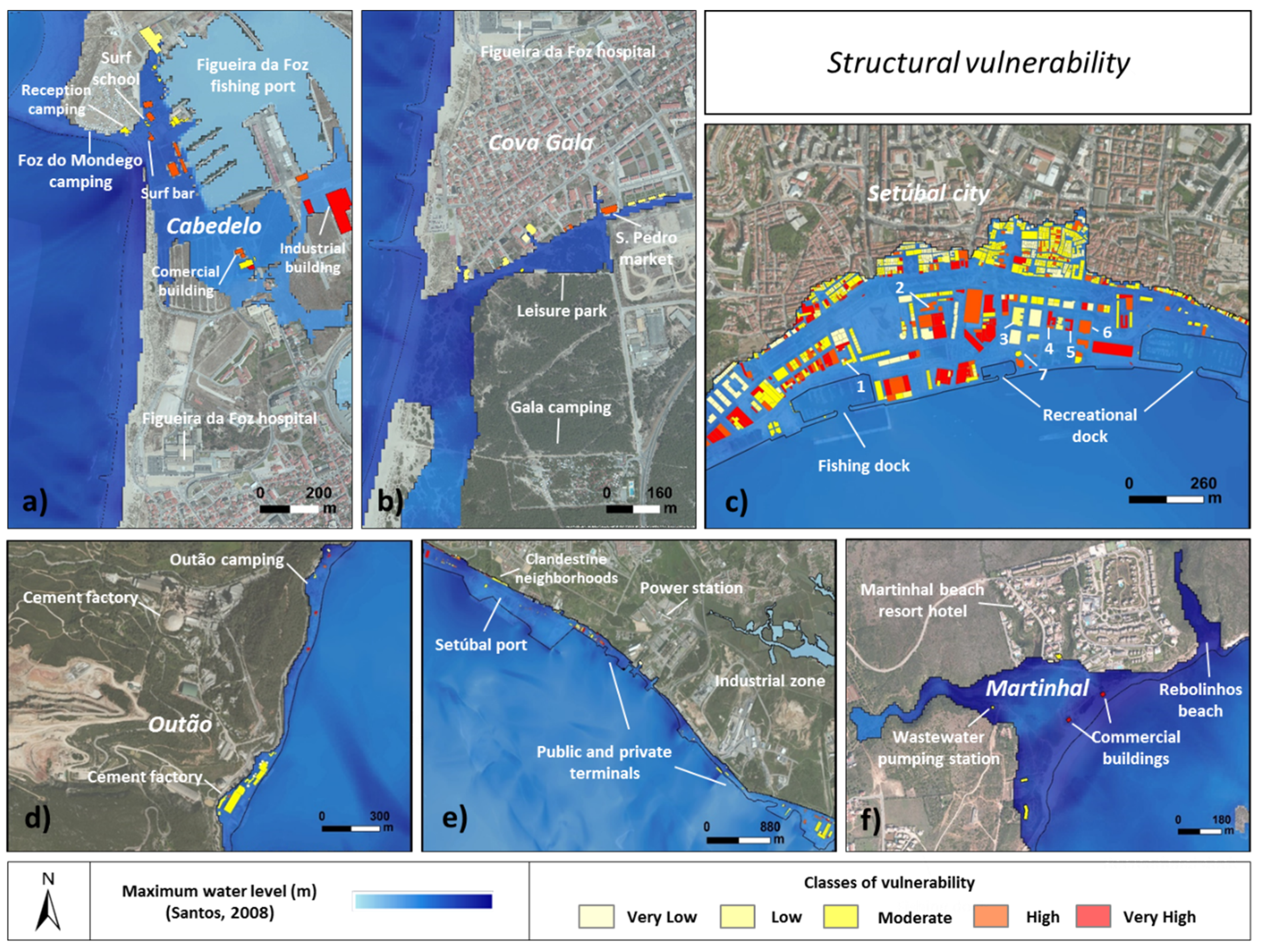
| Study Areas | Analyzed Buildings (% of Analyzed Buildings in the Total Municipality Affected Buildings) | Classes of Vulnerability | Number of Buildings by Class |
|---|---|---|---|
| Cabedelo | 15.3 | Low | 1 |
| Moderate | 10 | ||
| High | 8 | ||
| Very High | 3 | ||
| Cova Gala | 10.4 | Very Low | 2 |
| Low | 8 | ||
| Moderate | 1 | ||
| High | 4 | ||
| City of Setubal | 62.8 | Very Low | 219 |
| Low | 202 | ||
| Moderate | 519 | ||
| High | 166 | ||
| Very High | 153 | ||
| Outão | 2.3 | Very Low | 6 |
| Low | 1 | ||
| Moderate | 16 | ||
| High | 5 | ||
| Very High | 4 | ||
| Industrial zone | 23.3 | Very Low | 38 |
| Low | 28 | ||
| Moderate | 86 | ||
| High | 59 | ||
| Very High | 114 | ||
| Martinhal | 7.0 | Very Low | 1 |
| Low | 1 | ||
| Moderate | 3 | ||
| Very High | 2 |
4. Discussions and Conclusions
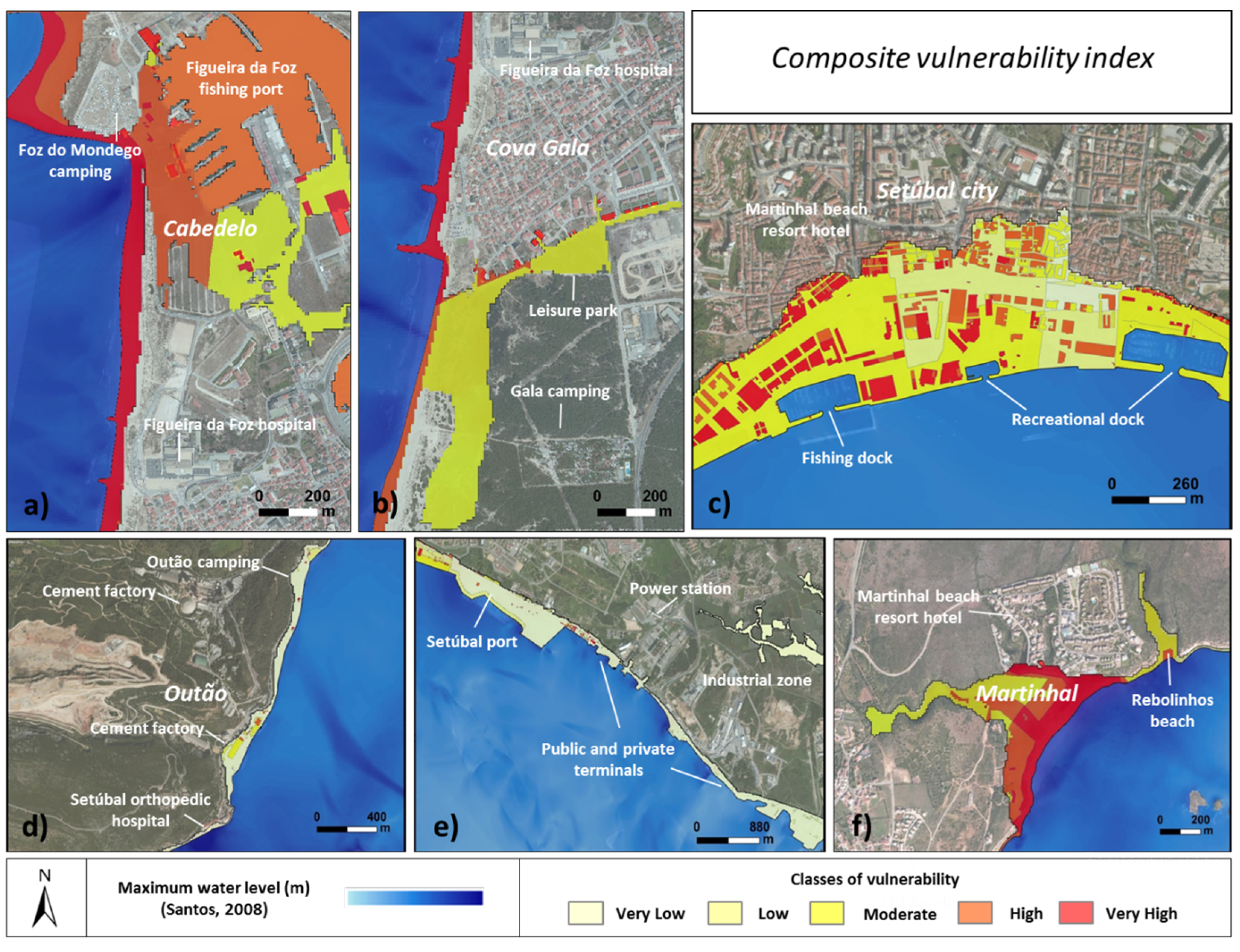
| Type of the Area | CVI | (%) of Area |
|---|---|---|
| Beach-use areas | Low | 2 |
| Moderate | 24 | |
| High | 50 | |
| Very High | 24 | |
| Residential areas | Very Low | 3 |
| Low | 15 | |
| Moderate | 55 | |
| High | 12 | |
| Very High | 15 | |
| Industrial areas | Very Low | 82 |
| Low | 10 | |
| Moderate | 6 | |
| High | 1 | |
| Very High | 1 |
| Typology of the Area | Structural Vulnerability | (%) of Buildings | Typology of Building | (%) of Buildings |
|---|---|---|---|---|
| Beach-use areas | Very Low | 3 | Exclusively Residential | 14 |
| Low | 7 | Commercial | 17 | |
| Moderate | 45 | Services/Industry | 35 | |
| High | 28 | Outbuilding/warehouse | 34 | |
| Very High | 17 | – | – | |
| Residential areas | Very Low | 17 | Exclusively Residential | 30 |
| Low | 17 | Commercial | 9 | |
| Moderate | 41 | Services/Industry | 1 | |
| High | 13 | Outbuilding/warehouse | 1 | |
| Very High | 12 | Mixed type | 55 | |
| – | – | Critical buildings | 4 | |
| Industrial areas | Very Low | 12 | Exclusively Residential | 25 |
| Low | 8 | Commercial | 8 | |
| Moderate | 29 | Services/Industry | 26 | |
| High | 18 | Outbuilding/warehouse | 29 | |
| Very High | 33 | Mixed type | 8 | |
| – | – | Critical buildings | 4 |
Acknowledgments
Author Contributions
Conflicts of Interest
References
- Santos, A.; Koshimura, S. The Historical Review of the 1755 Lisbon Tsunami. J. Geodesy Geomat. Eng. 2015, 1, 38–52. [Google Scholar]
- Santos, A. Tsunami Hazard Assessment in Portugal by the Worst Case Scenario: The November 1st, 1755 Lisbon Tsunami. Ph.D. Thesis, Tohoku University, Sendai, Japan, 11 September 2008. [Google Scholar]
- Baptista, M.; Miranda, J. Revision of the Portuguese catalog of tsunamis. Nat. Hazards Earth Syst. Sci. 2009, 9, 9–25. [Google Scholar] [CrossRef]
- Small, C.; Nicholls, R.J. A global analysis of human settlement in coastal zones. J. Coast. Res. 2003, 19, 584–599. [Google Scholar]
- Balk, D.; Montgomery, M.R.; McGranahan, G.; Kim, D.; Mara, V.; Todd, M.; Buettner, T.; Dorélien, A. Mapping urban settlements and the risks of climate change in Africa, Asia and South America. In Population Dynamics and Climate Change; Guzmán, J.M., Martine, G., McGranahan, G., Schensul, D., Tacoli, C., Eds.; United Nations Population Fund (UNFPA), International Institute for Environment and Development (IIED): New York, NY, USA; London, UK, 2009; pp. 80–103. [Google Scholar]
- Neumann, B.; Vafeidis, A.T.; Zimmermann, J.; Nicholls, R.J. Future Coastal Population Growth and Exposure to Sea-Level Rise and Coastal Flooding—A Global Assessment. PLoS ONE 2015, 10, e0131375. [Google Scholar] [CrossRef] [PubMed]
- IOC/UNESCO. IMO, FAO, UNDP. A Blueprint for Ocean and Coastal Sustainability; IOC/UNESCO: Paris, France, 2011. Available online: http://www.stakeholderforum.org/fileadmin/files/Opening%20Watson-Wright%20Monaco.pdf (accessed on 9 September 2015).
- Lichter, M.; Vafeidis, A.T.; Nicholls, R.J.; Kaiser, G. Exploring Data-Related Uncertainties in Analyses of Land Area and Population in the “Low-Elevation Coastal Zone” (LECZ). J. Coast. Res. 2011, 27, 757–768. [Google Scholar] [CrossRef]
- Mcgranahan, G.; Balk, D.; Anderson, B. The rising tide: Assessing the risks of climate change and human settlements in low elevation coastal zones. Environ. Urban. 2007, 19, 17–37. [Google Scholar] [CrossRef]
- Estatégia Nacional Para a Gestão Integrada da Zona Costeira; Instituto da Água: Lisbon, Portugal, 2009. Available online: http://w3.ualg.pt/~jdias/JAD/ebooks/ENGIZC_JAD.pdf (accessed on 20 February 2015).
- European Environment Agency (EEA). The Changing Faces of Europe’s Coastal Area; European Environment Agency (EEA): Copenhaga, Denmark, 2006. [Google Scholar]
- Santos, A.; Mendes, S.; Corte-Real, J. Impacts of the storm Hercules in Portugal. Finisterra 2014, 98, 197–220. [Google Scholar] [CrossRef]
- Santos, A.; Koshimura, S.; Imamura, F. The 1755 Lisbon Tsunami: Tsunami source determination and its validation. J. Disaster Res. 2009, 4, 41–52. [Google Scholar]
- Papathoma, M.; Dominey-Howes, D.; Zong, Y.; Smith, D. Assessing tsunami vulnerability, an example from Herakleio, Crete. Nat. Hazards Earth Syst. Sci. 2003, 3, 377–389. [Google Scholar] [CrossRef]
- Papathoma, M.; Dominey-Howes, D. Tsunami vulnerability assessment and its implications for coastal hazard analysis and disaster management planning, Gulf of Corinth, Greece. Nat. Hazards Earth Syst. Sci. 2003, 3, 733–747. [Google Scholar] [CrossRef]
- Dominey-Howes, D.; Papathoma, M. Validating a tsunami vulnerability assessment model (the PTVA model) using field data from the 2004 Indian Ocean tsunami. Nat. Hazards 2007, 40, 113–136. [Google Scholar] [CrossRef]
- INE. Instituto Nacional de Estatística, Censos de Portugal de 2011. Available online: http://www.ine.pt (accessed on 20 February 2015).
- Henriques, E.B. A cidade, destino de turismo. Rev. Fac. Letras Geogr. 2003, XIX, 163–172. [Google Scholar]
- Santos, A.; Tavares, A.O.; Emidio, A. Comparative tsunami vulnerability assessment of an urban area: An analysis of Setúbal city, Portugal. Appl. Geogr. 2014, 55, 19–29. [Google Scholar] [CrossRef]
- Pendleton, E.; Barras, J.; Williams, S.; Twichell, D. Coastal Vulnerability Assessment of the Northern Gulf of Mexico to Sea-Level Rise and Coastal Change. U.S Geological Survey Report, 2010–1146. Available online: http://pubs.usgs.gov/of/2010/1146/pdf/ofr2010-1146.pdf (accessed on 1 October 2014).
- Ismail, H.; Abd Wahab, A.; Mohd Amin, M.; Mohd Yunus, M.; Jaffar Sidek, F.; Esfandier, J.B. A 3-tier tsunami vulnerability assessment technique for the north-west coast of Peninsular Malaysia. Nat. Hazards 2012, 63, 549–573. [Google Scholar] [CrossRef]
- Dall’Osso, F.; Gonella, M.; Gabbianelli, G.; Withycombe, G.; Dominey-Howes, D. A revised (PTVA) model for assessing the vulnerability of buildings to tsunami damage. Nat. Hazards Earth Syst. Sci. 2009, 9, 1557–1565. [Google Scholar] [CrossRef] [Green Version]
- Cutter, S.; Boruff, B.; Shirley, W. Social vulnerability to environmental hazards. Soc. Sci. Q. 2003, 84, 242–261. [Google Scholar] [CrossRef]
- Schmidtlein, M.; Deutsch, R.; Piegorsch, W.; Cutter, S. A Sensitivity Analysis of the Social Vulnerability Index. Risk Anal. 2008, 28, 1099–1114. [Google Scholar] [CrossRef] [PubMed]
- Mendes, J.M. Social Vulnerability Indexes as Planning Tools: Beyond the preparedness paradigm. J. Risk Res. 2009, 12, 43–58. [Google Scholar] [CrossRef]
- Chen, W.; Susan, S.; Emrich, C.; Shi, P. Measuring social vulnerability to natural hazards in the Yangtze river delta region, China. Int. J. Disaster Risk Sci. 2013, 4, 169–181. [Google Scholar] [CrossRef]
- AT Autoridade Tributária e Aduaneira. Available online: http://www.e-financas.gov.pt/SIGIMI/default.jsp (accessed on day February 2015).
- PORDATA. Base de dados Portugal Contemporâneo. Available online: http://www.pordata.pt (accessed on 20 February 2014).
- Carta Social. Available online: http://www.cartasocial.pt (accessed on 18 February 2014).
- Comrey, A.; Lee, H. A First Course in Factor Analysis; Physiology Press: New York, NY, USA, 2009; pp. 1–430. [Google Scholar]
- Barros, J.L.; Emídio, A.; Santos, A.; Tavares, A.O. Composite Methodology for Tsunami Vulnerability Assessment Based on the Numerical Simulation of 1755 Lisbon Tsunami—Application on Two Portuguese Coastal Areas. In Safety and Reliability: Methodology and Applications; Taylor & Francis Group: London, UK, 2015; pp. 1581–1588. [Google Scholar]
- Mendes, J.M.; Tavares, A.O.; Freiria, S.; Cunha, L. Vulnerabilidade social aos riscos naturais e tecnológicos em Portugal. Rev. Crít. Ciênc. Soc. 2011, 93, 95–128. [Google Scholar]
- Bana e Costa, C.A.; Silva, P.A.; Correia, F.N. Multicriteria Evaluation of Flood Control Measures: The case of Ribeira do Livramento. Water Resour. Manag. 2004, 18, 263–283. [Google Scholar] [CrossRef]
- Bana e Costa, C.A.; Chargas, M. An example of how to use MACBETH to build a quantitative value model based on qualitative value judgements. Eur. J. Oper. Res. 2004, 153, 323–331. [Google Scholar] [CrossRef]
- Tavares, A.O.; Barros, J.L.; Santos, A. Tsunami Vulnerability in Two Coastal Areas of Portugal: A Multidimensional Approach. In Risk, Models and Applications, Lecture Notes in Information Sciences; CODATA: Berlin, Germany, 2015; Volume 7, pp. 91–103. [Google Scholar]
- Wisner, B.; Blaikie, P.; Cannon, T.; Davis, I. At Risk: Natural Hazards, People’s Vulnerability and Disasters, 2nd ed.; Taylor & Francis Group: London, UK, 2004; pp. 1–471. [Google Scholar]
- Atillah, A.; El Hadani, D.; Moudni, H.; Lesne, O.; Renou, C.; Mangin, A.; Rouffi, F. Tsunami vulnerability and damage assessment in the coastal area of Rabat and Salé, Morocco. Nat. Hazards Earth Syst. Sci. 2011, 11, 3397–3414. [Google Scholar] [CrossRef]
- Tavares, A.O.; Santos, P.P.; Freire, P.; Fortunato, A.B.; Rilo, A.; Sá, L. Flooding hazard in the Tagus estuarine area: The challenge of scale in vulnerability assessments. J. Environ. Sci. Policy 2015, 51, 238–255. [Google Scholar] [CrossRef]
- Santos, P.P.; Tavares, A.O. Basin Flood Risk Management: A Territorial Data-Driven Approach to Support Decision-Making. Water 2015, 7, 480–502. [Google Scholar] [CrossRef]
- Balica, S.F.; Wright, N.G.; van der Meulen, F. A flood vulnerability index for coastal cities and its use in assessing climate change impacts. Nat. Hazards 2012, 52, 73–105. [Google Scholar] [CrossRef]
- Adger, W.N.; Hughes, T.P.; Folke, C.; Carpenter, S.R.; Rockström, J. Social-ecological resilience to coastal disasters. Science 2005, 309, 1036–1039. [Google Scholar] [CrossRef] [PubMed]
- Gregg, C.E.; Houghton, B.F.; Paton, D.; Johnston, D.M.; Swanson, D.A.; Yanagi, B.S. Tsunami warnings: Understanding in Hawai. Nat. Hazards 2007, 40, 71–87. [Google Scholar] [CrossRef]
- Santos, A.; Tavares, A.O.; Queirós, M. Numerical modelling and evacuation strategies for tsunami awareness: Lessons from the 2012 Haida Gwaii Tsunami. Geomat. Nat. Hazards Risk 2015. [Google Scholar] [CrossRef]
- Vivacqua, A.S.; Borges, M.R. Taking advantage of collective knowledge in emergency response systems. J. Netw. Comput. Appl. 2012, 35, 189–198. [Google Scholar] [CrossRef]
- Spahn, H.; Hoppe, M.; Vidiarina, H.D.; Usdianto, B. Experience from three years of local capacity development for tsunami early warning in Indonesia: Challenges, lessons and the way ahead. Nat. Hazards Earth Syst. Sci. 2010, 10, 1411–1429. [Google Scholar] [CrossRef]
- Tavares, A.O.; Santos, P.P. Re-scaling risk governance using local appraisal and community involvement. J. Risk Res. 2014, 17, 923–949. [Google Scholar] [CrossRef]
- Birkmann, J.; Cardona, O.D.; Carreño, M.L.; Barbat, A.H.; Pelling, M.; Schneiderbauer, S.; Welle, T. Framing vulnerability, risk and societal responses: The MOVE framework. Nat. Hazards 2013, 67, 193–211. [Google Scholar] [CrossRef]
© 2015 by the authors; licensee MDPI, Basel, Switzerland. This article is an open access article distributed under the terms and conditions of the Creative Commons Attribution license (http://creativecommons.org/licenses/by/4.0/).
Share and Cite
Barros, J.L.; Tavares, A.O.; Santos, A.; Fonte, A. Territorial Vulnerability Assessment Supporting Risk Managing Coastal Areas Due to Tsunami Impact. Water 2015, 7, 4971-4998. https://doi.org/10.3390/w7094971
Barros JL, Tavares AO, Santos A, Fonte A. Territorial Vulnerability Assessment Supporting Risk Managing Coastal Areas Due to Tsunami Impact. Water. 2015; 7(9):4971-4998. https://doi.org/10.3390/w7094971
Chicago/Turabian StyleBarros, José Leandro, Alexandre Oliveira Tavares, Angela Santos, and André Fonte. 2015. "Territorial Vulnerability Assessment Supporting Risk Managing Coastal Areas Due to Tsunami Impact" Water 7, no. 9: 4971-4998. https://doi.org/10.3390/w7094971






